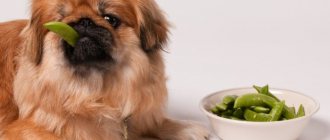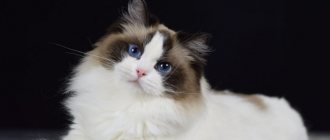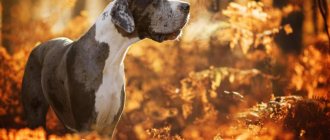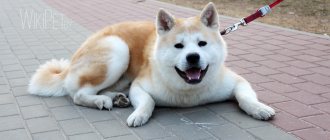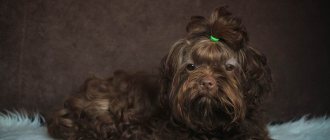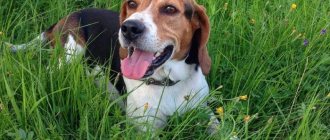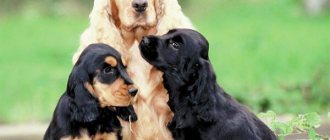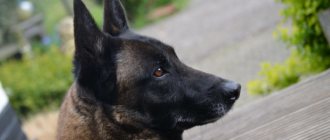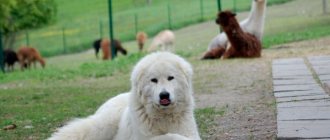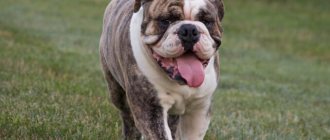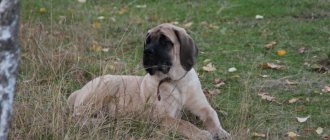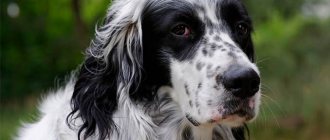Just don’t forget that this family member requires increased attention and acquiring one is a big responsibility.
Maintenance and care
The best place to keep a Great Dane would be a spacious private house, preferably with a large garden plot near a pond. However, a pet can be quite comfortable in a city apartment if it is given the opportunity to splash out all its accumulated energy during long daily walks.
Many people are hesitant to have Great Danes in an apartment because of their size, assuming that such a dog will take up too much space. However, as evidenced by reviews from experienced owners, Great Danes manage to be inconspicuous and compact, behave quietly and show great respect for the personal space of all family members.
A separate place should be equipped for the animal - it should be located in a separate corner, where the dog will not be touched by the feet of household members scurrying from room to room. You should not place the dog bed near heating appliances, or in places where drafts often occur - wind, as well as excessive dry air, has the most adverse effect on dogs and leads to the development of serious diseases.
In order for your pet to be comfortable and comfortable, you need to buy a high mattress that will correspond to the size of the dog. If possible, try to purchase a special sofa for dogs, since as animals age, they often develop problems with the spine, and a thin mattress will not be enough for them.
It is strictly forbidden to keep an animal in a booth or enclosure, especially during the cold season. The only exception is when you have built a heated house for your pet, but then the booth must be very spacious and voluminous.
If dogs live in a private house with the possibility of 24-hour self-walking, then this has a very good effect on the pet’s health. But if the animal is kept in an apartment, then the need for physical activity should be satisfied through walks - the dog should be walked twice a day, for at least 1.5-2 hours.
To maintain your pet’s impeccable appearance, you need to brush its fur once a week with a special stiff brush. Great Danes are bathed infrequently - 3-4 times a year and in case of heavy pollution.
Keep in mind that this procedure is not at all simple - a dog of this size will not fit in a basin, so the washing procedures will have to be carried out in the bathroom. Many breeders use the services of groomers. If you intend to bathe your dog yourself in your own bathroom, then try to accustom your pet to these procedures from early childhood.
Once every 5-7 days, the animal’s ears should be examined for inflammation, earwax discharge and injuries. During the examination, it is necessary to treat the inner surface with a special veterinary lotion or a weak solution of boric acid.
You should brush your Great Dane's teeth at least once a week. This can be done using a special paste and brush, or you can give preference to special “long-lasting” bones that help remove tartar in dogs.
Usually, dogs’ claws grind down on their own, but if the animal walks mainly in a forest belt or in an area with soft ground, then you will have to trim them from time to time with special clippers, since they will not grind off on the road surface.
You need to wipe your eyes a couple of times a week with chamomile infusion or a weak solution of furatsilin. Prophylactic instillation of anti-inflammatory drops every 10-14 days will not hurt.
Ear cropping
The issue of ear cropping deserves special attention. In accordance with the standard adopted in Germany, for a long time the ears of Great Danes were subject to mandatory cropping in order to reduce the risk of injury to the animal during hunting.
However, over time, the purpose of the dog has changed, and today Great Danes are more of guards and companion dogs, so the need for cosmetic trimming has disappeared. Moreover, since 1993, a new standard has been issued in the European Union, which established a ban on ear cropping - violation of this requirement is subject to a fine or other types of liability.
In Russia, this issue is left to the discretion of breeders; docking continues to be valued, but at the same time, at exhibitions and competitions, both groups of participants compete on equal terms. In any case, the final decision on ear correction is made by the breeder after consultation with a veterinarian.
Content
There should be no difficulties in caring for your pet, but you need to brush it regularly with a brush or a special rubber mitten. The large size of the dog tends to use dry shampoo for washing, as injuries can occur while washing off the foam products. The Great Dane is a fairly intelligent animal. But it is worth starting his training as early as possible. If you don’t teach your dog basic things in time, this will cause difficulties with maintenance and training in the future. It is customary to call this breed the Marbled Great Dane. Another name is royal or tiger. You should start raising a puppy immediately after purchasing it. Physical punishment and scolding should not be used on the dog, because such methods will make its character difficult. You should treat a Great Dane in the same way as a child. If he cannot do something, then it is worth providing a worthy alternative.
The Great Dane lives for about seven and a half years. To maintain health, careful monitoring is required, especially of the gastrointestinal tract. The digestive system is a weak point in such dogs. After feeding, you need to protect your pet from physical activity for at least forty minutes. Regular visits to the veterinarian and an adequate response to problems with the dog’s health are the key to his health and your joy for many years.
Keeping a Great Dane
Royal Poodle
Due to its outstanding size, the Great Dane is better off living in a spacious country house with a garden area. But an apartment is also suitable, provided that the dog is walked regularly and fully.
The owner will also have to put up with traces of the pet's drool on furniture and clothing, as well as short, coarse hairs everywhere. Yes, “Their Majesties” shed and drool. Otherwise, this dog is completely problem-free and does not cause much trouble in care and maintenance.
Care and hygiene
- Wool – once a week, it is enough to wipe the dog with a damp cloth, removing dirt and dust from the fur. Water procedures are recommended only for severe contamination. Frequent use of detergents can cause dermatitis. And the dog itself is not a fan of bathing, so experts advise using dry shampoos. During the shedding period, you need to have a rubber brush, which is used daily while the process is intense.
- Nails – with good walking, they wear down naturally and do not require trimming.
- Eyes – need regular monitoring and examination, as Great Danes are prone to ophthalmological diseases. Daily normal discharge is removed with a cotton pad soaked in chamomile decoction or furatsilin solution.
- Ears - need to be examined, especially if they are not cropped. Getting dirt and water into the ear can cause otitis media.
Great Dane diet
There are 2 options for feeding the Great Dane - natural or ready-made dry food. Experts advise giving preference to the first option, although it is more troublesome. If the choice is made in favor of ready-made food, then only specialized lines are suitable for the Great Dane - for dogs of large and giant breeds - premium class and higher.
With natural feeding, the size and appetite of the dog should be taken into account. The daily portion is divided into two times. The morning bowl is slightly less (45%) than the evening bowl (55%). The diet cannot be changed abruptly and radically. New products are being introduced gradually.
There are 7 main foods that should be present in the Great Dane's diet:
- Meat – lean varieties, except pork. Can be served raw, scalded or boiled.
- By-products are given only in boiled form.
- Poultry meat – chicken, turkey. No tubular bones!
- Porridge - cooked on the basis of meat broth, along with meat. Preference is buckwheat, rice, oatmeal.
- Cottage cheese and other fermented milk products.
- Vegetables - with the exception of legumes and potatoes. They are not digestible.
- Fish - sea varieties and without large bones. It is given boiled.
Diseases and breed defects
Great Danes suffer from diseases typical of large dogs. Their weak points are joints, skin, intestines, eyes and heart.
- Joints – dysplasia of the elbow and hip joints, arthritis, bone diseases – bone cancer.
- Skin – granulomas, demodicosis, dermatitis, histiocytoma.
- Intestines - volvulus of the intestines or stomach, bloating of the peritoneum, gastritis, colitis, flatulence.
- Eyes – eversion or inversion of the eyelids, cataracts, glaucoma.
- Heart – aortic stenosis, cardiomyopathy.
Education and training
Natural intelligence does not exempt Great Danes from training, and their owners from knowing some rules for raising pets and observing them. An ill-mannered giant is much more dangerous than a spoiled Yorkie and can cause a lot of problems.
Rule #1 - start early
Great Danes grow quickly and their behavioral skills are also strengthened quickly, due to their natural intelligence and extraordinary mind. Therefore, a 2-month-old puppy can and should be taught to follow basic commands.
Rule #2 - patience and encouragement
Due to the same mind, Great Danes are very susceptible to praise and intonations. They are also proud and should not be shouted at, much less physically punished. You can get an aggressive or intimidated neurotic. They will understand the owner’s dissatisfaction both by his gaze and by his gesture.
You should also take into account the natural slowness of the Great Dane. He learns quickly but executes slowly.
Rule No. 4 - variety and change of activity
The tedious execution of the same commands is not an activity for such a highly intelligent person as the Great Dane. To learn basic commands, two lessons are enough for him. And if the Great Dane gets bored during training, he will turn around and leave
And then it will be very difficult to attract his attention
Origin of the breed
The Great Dane is a descendant of Tibetan mastiffs. This opinion is shared by some breeders and owners of the breed. Another part supports the theory of Reiber, a famous German dog handler. Still others lean towards the eastern roots of the Great Dane dog breed.
Those who consider the Tibetan mastiff to be the ancestor of the Great Dane are right. Powerful and large dogs are widespread in the Near and Middle East, India, Nepal and Persia. Dogs were used as hunters and guards; the oldest depiction of a battle between a Tibetan mastiff and a lion has been preserved. But the dog's main vocation was war. Menacing and vicious, they inflicted severe injuries on their opponents.
As time passed, representatives of the breed accompanied numerous armies on the battlefields. Thanks to this, mastiffs came to Molossia (present-day Albania), and then to Greece. According to some sources, Alexander the Great became interested in the breed, but there is a version that he was a fan of Great Danes. Due to this, representatives of the breed have become widespread worldwide.
The Romans learned about powerful and vicious dogs. They began to buy representatives of the breed to participate in wars and battles. Ancient Rome is famous for its Colosseum; not only slaves and gladiators died in its arena, but also dogs. Such bloody entertainment continued for a long time; if the Roman army did not take part in military campaigns, the mastiffs entertained the most respectable public with battles.
During another conquest mission, the Romans encountered the Celts. They turned out to be the owners of muscular and powerful dogs that managed to give worthy resistance to the Roman mastiffs. According to one version, some of the mastiffs went to the Celtic army as trophies. They were crossed with their Great Danes, as a result of which a new dog was born, more flexible and muscular than its ancestors, characterized by increased aggression towards strangers and fellow dogs.
In the Middle Ages, the Great Dane breed became widespread in Europe. Only representatives of the nobility could afford to keep such a dog. For some time, representatives of the breed ceased to be used for military purposes. They went hunting with them or were used as guards. But with the discovery of the New World, animals again went on the “warpath”. The Spanish conquerors brought them to America; the Great Danes turned into cruel and merciless killers, because they were set against the Indians who inhabited the mainland.
The first description of Great Danes appeared in the 16th century. Five main types have been identified, and a variety of colors are noted. In those days, the exterior of Great Danes was somewhat different from that of modern dogs. Representatives of the breed were distinguished by a powerful chest and excessive growth, given the size of current dogs.
The breed's popularity took off in the 19th century. Great Danes lived in palaces and were kept by noble people. Dogs of that time were distinguished by their tall stature, harmonious physique and sophistication. In the 19th century, the standard of modern representatives of the breed was born, and special attention was paid to its purebredness. Depending on the area, their own types of dogs were formed - Welsh, Danish and others.
When the time came to write a breed standard, the Danes tried to adapt it to their dogs. But the animals described contradicted the general program for breeding Great Danes. German dog breeders rebelled against the Danish ones, and a serious struggle ensued. The Germans won, the Danes were left empty-handed, and soon their dog breed disappeared. Although the Great Dane is still mistakenly called Danish.
The current breed standard was written in 1879. Then, under the leadership of the director of the Berlin Zoo, and also a dog handler, a commission was assembled to adopt a single standard. In the same year, a book called “Great Dane” was published, in which the breed standard was published.
In Russia, its representatives appeared even before the revolution. They were supported by those close to the royal family. During the Great Patriotic War, Great Danes practically disappeared, but Moscow breeders and enthusiasts set about reviving the breed.
At the moment, Great Danes are less popular than in the Soviet Union. However, there is a demand for puppies, new nurseries are being created in Russia.
Care and maintenance
Dwarf and Royal Pekingese
No matter who says it, keeping a dog of such impressive size is, to put it mildly, difficult. The pet cannot stand the cold, since it does not have an undercoat, it will be very cold in the winter. An exception is an enclosure with a heated cabin, but this is provided that the enclosure itself is spacious.
Of course, the ideal option for keeping a Great Dane is a private house with a large, fenced area. The pet will be able to move freely, run and walk. Large dogs need daily exercise and cannot be kept within four walls. If you keep your pet in an apartment, you need to provide it with at least two hours of active walks outside.
The dog should have his own place in the house where he can rest. If you don’t do this, he will choose his place himself; for example, he may like your bed, sofa or chair. If you want to avoid this, be sure to take care of creating a corner for your pet, lay a rug there, and place a bowl of water nearby. The dog must be accustomed to one feeding place. Under no circumstances feed him from the table, only from his own bowl.
In order for your pet to live happily ever after, you, as its owner, need to follow the following rules:
- It is necessary to periodically check the ears for inflammation, redness, injury or various types of discharge - if you detect at least one of the listed symptoms, immediately contact a veterinarian; this process should not be left to chance.
- Try to monitor the length of the claws, trim them only if the animal does not rub them off on its own on the surface on which it walks.
- Large portions of food must be served, because the pet is quite large. Protein-containing foods should make up the majority of your diet. Great Danes need a special diet, the nuances of which should be discussed with your veterinarian, he will tell you what is best to include in your pet’s diet.
- Owners need to comb the coat every 6-8 days, it is better to do this with a stiff comb.
- Bathe your dog only when necessary; you don’t need to do this often. Water procedures can be carried out in the bathroom or in a basin. It is better to accustom your dog to washing from an early age.
- Be sure to brush your teeth daily. Together with brushes and pastes, you can buy special bones that will replace your usual procedure for brushing your dog’s teeth.
Education and training
As mentioned above, due to their nature, Great Danes require early socialization. You should start training them no earlier than 4 months of age; by this time the puppy must learn:
- respond to your name;
- walk calmly on a leash and wearing a muzzle, without trying to remove the latter;
- walk indifferently past cars, cyclists, strangers;
- do not try to chase street cats;
- know the prohibiting command and respond to it the first time;
- live according to the rules established in the master's house.
Great Dane training is approached in such a way that the pet becomes interested in learning. First of all, it is necessary to establish close contact between the animal and its owner. Without contact, good training will not work; a dog can work great on the playground, but ignore commands in everyday life.
All training is based on the principle of “simple to complex” and positive reinforcement. If correction of undesirable behavior is necessary, then conditions are created for the dog under which the desire to behave incorrectly disappears. All this is done without mechanical impact on the animal. Hitting a Great Dane is unacceptable.
The sooner you start socializing your pet, the better for him and those around him.
Dogue de Bordeaux - description of the breed
Great Royal Poodle and other breed varieties
The Dogue de Bordeaux looks quite massive, but squat. The weight of adult males sometimes reaches 90 kilograms with a height of about 68 centimeters. Bitches are almost as big as them.
According to the exterior, experts distinguish three breed standards:
- Show standard. This group includes all animals that have ideal exterior characteristics;
- Breed standard. Bordeaux from this group have slight deviations from the standard, but participate in exhibitions and are successfully bred;
- Pet standard. Dogs in this category are not used for breeding and do not become exhibition grounds.
The Bordeaux is a large dog, characterized by a wide chest, stocky body, and large head. The muzzle always looks wrinkled due to the large number of folds. The nose is short and turned up. The ears have curved edges. The animal's lips are quite fleshy and its chin is powerful. The eyes are oval.
The limbs are very stable and strong. Powerful muscles are clearly visible on the animal’s hips. All joints stand out. The hind legs are slightly longer than the forelimbs and there are no dewclaws. The claws are very strong. The coat is short without undercoat.
The class of an animal is determined by the following indicators:
- The muscles of the cheekbones and cheeks are well developed;
- The eyes should be wide apart;
- The ends of the ears reach the line of the eyes and are always pressed tightly to the muzzle;
- The lower back is wide, and the chest circumference is 20-30 centimeters greater than height;
- Developed facial expressions.
Bordeaux's appearance is always gloomy or offended, but this is not an indicator of his real mood. The lower jaw of the Great Dane protrudes slightly forward and rises above the upper. All incisors are on the same line, and the bite is bulldog-shaped.
Breed standard
As written above, the Great Dane is a giant dog breed. According to the FCI, its representatives look like this:
- General appearance: very large, well built, muscular dog.
- The head is long, narrow, the transition from the forehead to the muzzle is clearly defined. The muzzle is long and square.
- The eyes are small and dark in color.
- The nose is large, the color depends on the color of the dog.
- The jaws are powerful, the lips are dry and close to them.
- The body is muscular, somewhat elongated, with a strong back and convex loin.
- The chest of Great Danes is round and well developed.
- The limbs are high and thin.
- The tail is set high, thick at the base, tapering towards the tip.
- The coat is short and shiny. Representatives of the breed do not have undercoat.
- Acceptable colors: marbled, black with white markings, blue, brindle, fawn.
- The minimum height for a male is 80 cm, for a female - 74 cm. Weight varies from 50 to 80 kg.
How to choose a puppy
Having decided to purchase a Dogue de Bordeaux, you need to determine the purpose of the purchase. Great Danes come in 3 classes:
- “Show” includes flawless Dogue de Bordeaux without breed defects, which are allowed to participate in exhibitions because they meet all the requirements of the breed standard.
- Breed class animals have slight deviations from the standard, which allows them to be used for breeding.
- Great Danes belonging to the “pet” class are dogs that become pets. They live for their own pleasure, faithfully serving the owner and his family.
The next step is to decide on the sex of the animal, since it has the following characteristics:
- When choosing a male dog, you need to know that he will claim independence and strive for leadership. These traits will require the owner to have stern strength of character when interacting with the pet.
- When giving preference to a bitch, you need to take into account her tendency towards feminine cunning and cunning.
Having decided on the class and gender, you need to find a trusted nursery. Before choosing a baby you need to:
Find out about his parents
Clarify their defects, since they will be inherited by the puppy. Review the documentation for the puppy (results of tests for dysplasia, pedigree certificate, veterinary passport). When meeting puppies, you need to pay attention to the behavior of the babies. Healthy dogs are curious and playful
They should not be overexcited or lethargic, hide cowardly, whine for no reason, or limp. Then check the dog’s name and brand with the veterinary passport.
After choosing a small dog, you can make a deal. The price of puppies depends on the following factors:
- class;
- gender;
- receiver location;
- availability of documents.
If the dog does not have a pedigree, it will cost from 5,000 rubles. Thoroughbred - from 20,000 to 80,000 rubles. No matter how much a Great Dane costs, whether it lives up to the owner’s expectations at exhibitions or simply becomes a pet, in any case a faithful and devoted friend, charming and beloved, will appear in the house.
Brazilian
The Dogo Brasileiro is better known as the Fila Brasileiro. This is a large representative of the Molosser, reaching 60-75 cm at the withers, and in weight - from 40 to 90 kg. The exact origin of dogs is unknown, but there is information that they were used as hunters, shepherds, watchmen, and chasers of slaves. Today, with proper training and timely socialization, Fila Brasileiros grow into excellent companion dogs and family pets.
In appearance, “Brazilians” are somewhat reminiscent of Dogo Argentinos. They are strong, muscular, massive. Their head is large, but its size is proportional to the body. The muzzle is long. The ears are not set high, long and drooping. The eyes are in the shape of tonsils or triangles. Limbs parallel, straight.
The coat comes in short and medium length. It is dense, hard and shiny. The most common colors are black, white, and brown. Various variations are possible.
By temperament, these dogs are friendly, loyal, courageous, decisive, vigilant, and balanced. They are wary of strangers, tolerant of children.
The average life expectancy is 12-13 years. Prices for puppies start at $400.
Nutrition
Ready-made food, which is sold for various breeds and in large quantities, does not have a very good effect on the already delicate health of the Great Dane. And in terms of price, it’s not cheap. One package of 20 kg scales is enough for a month. The dog is fed 2 times a day, and the morning portion should be slightly larger than the evening portion.
If you choose a method of feeding natural food, then you need to calculate your strengths and capabilities in preparing dishes for your pet. His portions are much larger than those of an ordinary dog. What is left uneaten from the table cannot be given to the dog. Food should always be fresh, and water should be clean and in the right quantity. You can’t feed before a walk, it’s bad for a weak stomach.
The most useful products for him:
- boiled and peeled sea fish;
- chicken, turkey, beef;
- porridge;
- fruits.
200 gr. – this is the maximum amount per day that a growing puppy should gain up to one year. Be sure to include foods high in calcium in your diet.
The largest Great Danes living in the world
So, which representatives of the breed are the largest? The photo shows the largest Great Dane in the world. His name was George, a blue dog lived in America, along with his owners. The giant's weight reached 111 kg, height - 110 cm at the withers. George's height, standing on his hind legs, exceeded all conceivable and inconceivable limits. He was 213 cm.
The dog died in 2013, a few days before his 8th birthday.
He was replaced by a Great Dane named Zeus. This male is 1 cm taller than his predecessor, his height is 111 cm.
Temperament of Great Danes
The Great Dane has excellent sociable qualities and behaves superbly in any environment. Large dimensions and a slightly stern, concentrated look generally cause caution, but this is in vain, because there is simply no kinder and more affectionate companion among dogs.
Aggression is unusual for this breed of dog. An adult dog does not waste his energy; his movements are always deliberate, precise and graceful. In situations of confrontation with real danger, they act without delay, firmly and without showing unnecessary emotions. He is extremely uncomfortable with importunity, so it is not recommended to pester him too much. Great Danes are incredibly sociable and love to be with their family.
At an early age, hyperactivity and disobedience may occur, which goes away with age and becomes controllable. Socialization lessons will benefit them, they will be able to master any situation and grow up confident.
Possible diseases
There are no specific diseases unique to this breed. But Great Danes get sick no less than other dogs; most often they suffer from the following ailments:
- joint problems – dysplasia, osteochondrosis;
- heart disease - cardiomyopathy;
- ear diseases – otitis media, ear mites;
- infectious enteritis - affects the liver and digestive system;
- ulnar bursitis - a neoplasm in the form of a tumor, appears due to sleeping on a hard surface;
- volvulus of the stomach.
You should not self-medicate your dog. Some diseases, such as gastric volvulus, are fatal if you do not seek help from a veterinarian in a timely manner.
History of the origin of the species
The breeding of breeds under the general name “Dog” began in the early Middle Ages. The ancestors are considered to be mastiffs born in the Tibetan mountains, distinguished by their large size, strong character, and fearlessness. They were domesticated by pastoral tribes. Subsequently, two large groups were formed: Great Danes and Asian Shepherds.
During migration, dogs showed themselves to be reliable human companions, capable of protecting themselves and others, and always being there. They were especially valued during the development of Mesopotamian civilization. They participated in the battles of the Greek army and Roman civilization.
Once in Europe, the genes of bulldogs and wild boar dogs were added to the blood. Initially, all strong, strong, hardy dogs were called this, and later a division into breeds appeared. Since ancient times, the Great Dane has been used:
- as a participant in battles, including gladiator battles;
- as an assistant for hunting animals;
- in the role of guard of territory and housing.
The Great Dane is considered to be the direct ancestor of the Great Dane. In modern times, this is a companion dog that is always next to its owner.
Noble ancestors
Molossians are not the only ones who were noted during the formation of the breed. At the very, very beginning there were Asian fighting dogs. And if you are scrupulous, you can find information that even in those days the general branch was divided into two side branches. One was a pack dog, released on large animals in baiting, did not differ in large size and did not differ much from other hunting dogs. Another branch, which united much more massive individuals, was used primarily in protection. The Royal Dane breed originated from this line. To develop the necessary qualities, the original branch was crossed with greyhounds, the fastest dogs in the world, so that the bodyguard acquired the characteristics inherent in greyhounds.
Character of the English Great Dane
The English Dog's character is bad, much worse than that of the English Bulldog, that's why he's not married - it's a joke. Great Danes
very kind and slobbering hulks, but this kindness extends only to members of the family in which the English Great Dane lives, and to good friends of this family; the English Great Dane will treat everyone else with suspicion and sometimes even hostility.
If you already have pets in your home and you decide to get an English Great Dane puppy
, then you can do this without any fear, he will not have problems with other animals, especially if he grew up with them. At first, the puppy will play with the other inhabitants of the house, and when it grows up, it will become their reliable protection, and even if the neighbor’s cat tries to offend your Vaska, his great friend will immediately come to his aid.
Great Danes have no problems with children either; they quickly find a common language, and it doesn’t matter whether they are adults or very young children, an English Great Dane can become a faithful friend and playmate for a teenager, and a nanny and a comfortable soft bed for a child.
Character and behavior
The English Great Dane, which looks fierce and vicious, has a calm, gentle character. The kind, slobbering goofball dotes on all members of his family, including pets. However, he treats strangers with caution and suspicion.
The behavior of the English Mastiff can be characterized by the following epithets:
- nobility;
- calm;
- splendor;
- equilibrium;
- courage.
Not a trace remained of the aggressiveness and cruelty of his ancestors. This is the result of the work of skillful breeders who consciously tried to soften the ferocity of the character of the four-legged giant.
The Great Dane is distinguished by equanimity bordering on phlegmaticity. His restraint and endurance can be envied. It takes a lot of work to get a good-natured Great Dane excited. He will not bark over trifles.
The attachment of a Great Dane to its owner is sometimes aggravating in the literal sense of the word. The dog is not indifferent to strong hugs and will not miss the moment to jump onto the lap of its beloved owner. Everything would be fine if it weren’t for the impressive weight of the English Mastiff. Nursing such a “baby” is by no means easy.
The trembling and gentle giant has exemplary guard qualities. The Great Dane will not be the first to attack a stranger, but it will not allow the “enemy” to enter private territory. Having driven the enemy into a “corner”, a reliable watchman will wait for the owner to return.
As befits true aristocrats, the Great Dane loves to lie on the sofa for hours. Sport is not his element. Walking with the owner, the dog walks alongside him decorously and importantly, demonstrating to others his independence and power.
However, the calmness of the grenadier mastiff can disappear if he suddenly becomes interested in something. While running, a Great Dane can reach quite a high speed.
English mastiffs experience loneliness very painfully; they need constant communication. Leaving the giant bored for a long time, the owners risk returning to a destroyed apartment.
Children and English Great Dane
The English four-legged gentleman always has an excellent relationship with children, regardless of age. For the baby he will be a real nanny.
The only negative is that, due to its size, the Great Dane can accidentally knock a child down. Therefore, you should not leave the animal and baby unattended.
For a teenager, a Great Dane will be an excellent companion and reliable protection.
physical characteristics
Standard physical characteristics are as follows:
- according to the parameters of the NKC club, the male has a height of 58.4 to 68.6 cm and a weight of 36.3 to 56.7 kg, and the female has 55.9–66 cm and 27.2–47.6 kg, respectively;
- according to the standards of the ABNA union, the male is 56–71 cm and 31.5–54 kg, and the female is 51–66 cm and 27–45 kg.
The large head of the American Bulldog dog looks massive. The top of the skull is flat with a pronounced transition along the forehead-bridge line. There is a deep furrow on the forehead. The muzzle is distinguished by an upturned nose and thick, slightly sagging cheeks. They show black pigmentation.
- The most popular dog names in alphabetical order with recommendations
- Shar Pei - history of the breed, character traits, care and possible problems + 87 photos
- Yorkshire Terrier: history of the breed, features, choice of puppy, maintenance, health (83 photos + video)
The animal's eyes are round in shape, but can be elongated. They are located high. Iris is popular in dark brown tones. The cartilage on medium-sized ears is curved towards the muzzle, and sometimes to the side.
The muscular body is close in shape to a square. The deep chest is characterized by rounded ribs.
The adjacent coat is insignificant in length - up to 2.5 cm. White, fawn and red shades are popular. This can be clearly seen in the photo of the American Bulldog.
Caring for Dogue de Bordeaux
Important care requirements:
- The Dogue de Bordeaux, despite its short coat, requires regular brushing. Using a soft brush or rubber glove, remove lost hairs and dead skin;
- The Great Dane should be bathed and washed as soon as it gets dirty. The numerous folds on the animal's face require special attention. The skin in this area is very susceptible to infections, as dirt and saliva are retained on the face. After each meal, all folds are carefully cleaned with a damp cloth. After walks, it is necessary to treat the paw pads with an antiseptic lotion, check for cracks and injuries, and then moisturize with vegetable oil;
- You should examine your eyes and ears daily for redness and pus. Natural secretions and dirt are removed with a soft cloth soaked in a special lotion or strong tea. If there is inflammation, watery eyes, or a large amount of wax in the ears, a visit to the veterinarian is indicated. It is necessary to consult with a specialist and in the case when the animal behaves restlessly and often shakes its head;
- Chewing sticks, which can be purchased in specialized stores, are suitable for dental hygiene. In addition, teeth are cleaned with a brush and toothpaste. The claws are trimmed once a month using a nail clipper, and the edges are processed with a soft file.
To wash Bordeaux, it is better to use special shampoos and cleansers that will protect the animal’s skin from moisture loss. Quite often dry cleaning is sufficient.
Raising an English Great Dane
Raising an English Great Dane is a real pleasure; the dog is very calm. Easily remembers all commands and does not forget them throughout his life. However, raising a dog still needs to be done seriously; the dog must clearly know its place and not jump on sofas and chairs in the house. Be sure to teach your dog to jump on visiting friends while the Great Dane is still a puppy - it’s funny, when he turns into a huge dog, there will be problems.
Why can't an English Mastiff, just like a Spanish Mastiff, sleep on the bed with you? Yes, everything is simple, if you drag the puppy to bed at first - it’s funny and interesting, the puppy snorts funny, sleeps very funny on its back, it’s warm and pleasant to the touch, but it grows. After a while, you will no longer fit on the bed, and the dog is used to sleeping there; in the end, you will either need to make another bedroom in the house or move the hallway.
Educational rules
Like any other breed of dog, the Royal Dane has its own characteristics in education.
The generally accepted rule is not to hit an animal with your hand - if, of course, you want it to love you and not be afraid, not understanding your actions. Hands should remain a symbol of peace, affection and consolation. If you punish with your palm, you risk that a sick dog will bite you when you want to calm it down. Under the same nationwide ban, punishment remains in place of the animal. If it has already hidden itself on its mat, it means it has realized everything. And even a dog should have a “house”.
You need to spank - well, your dog has done something wrong, it happens - do it hard, but only once. Beating is the lot of executioners. Your anger or frustration will have a much stronger effect.
And most importantly: education begins from the moment a puppy appears in your home. Even if he is still a fool, he will check for weaknesses regularly. If you want to have an intelligent creature in your house instead of a domestic bandit, educate him!
Pros and cons of the breed
The Great Dane is a wonderful breed in many ways and has many advantages. However, these dogs also have quite serious disadvantages.
Let's list the advantages of these giants:
- Balanced character;
- beautiful appearance;
- developed intelligence and high learning ability;
- love children;
- get along well with other pets;
- behave intelligently;
- not prone to zoo aggression;
- know how to protect and protect;
- do not require complex care.
Now about the disadvantages of Great Dane dogs:
- Very large dimensions;
- cannot be kept outdoors in the Russian climate;
- high food costs;
- low life expectancy.
Origin and purpose
Actually, as everyone knows, “Dog” translated from English is a dog. That is, if you think logically, there are no other dogs except Great Danes. Quite a royal approach. But even among those breeds that bear this proud name, there is an aristocratic hierarchy. And the Royal Dane among them is the coolest and most important.
According to the main version, this breed originates from Molossian dogs, which were bred back in the days of Ancient Rome. According to some reports, they were then used to track down and persecute runaway slaves. In the dark Middle Ages, the ancestors of today's dogs enthusiastically hunted wild boars, poisoned bulls with them, and they also acted as bodyguards.
Times have changed. Along with them, the character of these dogs and their modern name changed. Now the Royal Dane is better known as the Great Dane.
How to choose a Great Dane puppy
The Great Dane is a very attractive dog, but quite difficult and expensive to keep. Think and answer a number of questions: can you provide the puppy with quality nutrition and veterinary care, are you ready to educate and train, will this giant be cramped in your home.
If you are firmly convinced that you want to get a Great Dane puppy, contact kennels that breed dogs of this breed. Find out how reputable a particular breeder is, read reviews about him on dog breeder forums, talk to him personally, go on a tour, see how the animals are kept.
When it comes to choosing a Great Dane puppy, pay attention to whether the appearance matches the breed standard and the character of the future pet. Choose an active and moderately well-fed kitten, with shiny fur, clean ears and eyes, a flat back, he should be playful and curious
The success of living together is in education
In the modern world, the Royal Dane (also known as the Great Dane) dog has acquired all the qualities necessary for its current survival, but has not lost those thanks to which it gained its historical position.
The main thing about this breed is the ability to get along with almost any normal person. But! If you want to be not a service person, but at least an equal participant in the relationship, be able to prove it to the dog. Let's start with the fact that the Great Dane is a proud animal, so you should beat and scold him only in cases where he is really guilty. Otherwise, the dog may consider you an unfair (read: abnormal) owner and will continue to ignore you as incompetent. A reproachful tone and trust will be more effective, even when the puppy is naughty. At the same time, remember: if you give in and the dog doesn’t recognize you, you won’t get a comfortable existence, there will be a constant quiet war for supremacy.
How healthy are these animals?
Although the Great Dane does not live very long (like other large dogs), it is in fairly good health. If the puppy does not have hip dysplasia (these are usually discarded, but suddenly you came across an unscrupulous breeder), then the Great Dane will not bring you childhood diseases. It happens that these dogs get bloated, but you just need to watch their diet. Glaucoma, which sometimes occurs, is also usually associated with poor diet. With age, Great Danes can develop a variety of musculoskeletal diseases; slightly more likely than other breeds to become deaf; but in general they are quite problem-free animals. And most importantly, the Royal Dane (photo attached) is a very calm dog, friendly to children and not shrill. For their lack of “emptiness,” these beauties are especially respected by dog lovers.
Character needs to be taken into account
The character of the Great Dane itself provides great assistance in education. First of all, he is patient. Even if the dog doesn’t understand something (for example, why it’s forbidden to chew on its owner’s slippers), it will wait and try to understand why this is prohibited. This same quality is very useful if there are children in the family. Their Royal Dane will endure for a very long time - and without tragic consequences. However, this dog is stubborn and quite headstrong. So if your views on some everyday features of coexistence do not coincide, you will have to look for a compromise. Agree, the “king” has the right to his opinion.
Health and illness
Welsh Corgis are strong, healthy dogs that can live up to 12-14 years with proper care. But there are genetic diseases to which they are prone. This breed is often diagnosed with eye diseases: glaucoma, cataracts, progressive atrophy, and retinal dysplasia. Of course, these conditions are more common in older Corgis, but young Pembrokes and Cardigans are prone to lens luxation, which can lead to partial or complete loss of vision. In most cases, surgery helps.
photo: depositphotos.com
Since Welsh Corgis are prone to obesity, this can lead to organ overload and joint deformation.
Therefore, it is important not to overfeed your dog or give him treats from the table, and also to keep him physically active. Hip dysplasia can lead to loss of mobility in the hind limbs
In the initial stages, they can be treated with medication, but in the later stages, surgery cannot be avoided.
Among skin diseases, Pembrokes and Cardigans are prone to raw eczema. Dogs itch, gnaw out pieces and behave restlessly. The fur around the wounds should be shaved to provide oxygen access and treated with an antiseptic. You also need to make sure that the corgi does not lick the wounds, for which they put a dog collar on their neck.
Due to its massive body and short legs, the Corgi runs the risk of injuring its back, causing problems with intervertebral discs. If analgesic therapy does not produce results within 1-2 weeks, surgical intervention is considered. Dogs should also temporarily limit their physical activity. Damage to the spinal cord can cause degenerative myelopathy, an inability to control the muscles of the hind legs. The disease develops gradually and cannot be treated. Not only older dogs are prone to it, but also young dogs who have been injured. Poor nutrition and excessive exercise only aggravate the situation.
photo: depositphotos.com
Corgis are predisposed to a hereditary disease - von Willeband's disease, in which blood clotting is impaired and bleeding occurs. After injuries and operations, dogs are given antithrombotic therapy. Prolonged stress and tension provoke the development of epilepsy. Cramps occur at night or early in the morning
It is important that the dog’s head is raised at this moment and that there are no sharp objects around. This disease is treated with medication
Narcolepsy or sudden heavy sleep is another hereditary disease of the Welsh Corgi. Antidepressants are used to treat it, but they do not always help. The pet is provided with comfortable conditions by placing it in a closed space, and dangerous situations are prevented during an attack. Kidney stones are common in this breed. If medications do not help eliminate the problem, surgery is performed to remove them.
photo: depositphotos.com
Dental problems are rare in Pembrokes and Cardigans. To prevent the formation of tartar, special toothpastes are used. Already existing plaque must be removed.
As Corgis age, they can develop arthritis. They may also suffer from difficult labor, skin asthenia, hypothyroidism and other diseases. Timely visits to the veterinarian and vaccinations will help avoid unwanted health problems in the future. Vaccinations for this breed are given on schedule and help keep the dog healthy for many years.
Vaccinations and susceptibility to disease
The outwardly strong, powerful mastiff can suffer from some serious ailments. The most common ones include:
- Joint diseases (dysplasia and osteochondrosis). The physical activity of a Great Dane puppy is limited until it is one and a half years old so that the joints are fully formed and strengthened.
- Digestive problems (bloating, gastric volvulus, intestinal obstruction). You need to carefully select the diet and not physically burden the animal immediately after eating.
- Heart failure. Thickening of the walls of the heart leads to the fact that the organ is unable to pump blood. The dog's behavior becomes lethargic and apathetic. Sometimes they resort to medicinal treatment of the animal.
- Labored breathing. Due to the natural curvature of the nasal passages, the Great Dane sometimes finds it difficult to breathe. In especially severe cases, surgical intervention is resorted to.
The lifespan of an English Great Dane ranges from 6 to 10 years. And in order for the four-legged giant to spend them in health, the owner needs to vaccinate the animal against all kinds of infections on time:
- plague;
- parvovirus enteritis;
- parainfluenza;
- rabies;
- infectious hepatitis;
- leptospirosis;
- trichophytosis;
- coronavirus.
The first vaccination is given to the English Mastiff at 2 months of age. It is tolerated by dogs quite hard: with fever, general weakness and diarrhea. The second vaccination is carried out 3 weeks later. This time the puppy feels lighter.
At six months they are given a rabies vaccination and a complex vaccine against a group of diseases. If your puppy's teeth change during this period, you should wait it out.
At 12 months - a comprehensive vaccination, which is repeated every year thereafter.
Regular care, proper nutrition, daily walks with physical activity will make the life of your beloved pet happy and fulfilling.
Living conditions for a Great Dane
The breed was obtained for protection. Therefore, behind the kindness of these dogs there is a guard instinct. Owners of a pet of this wonderful breed should know how to introduce it to their household.
It is important to do this correctly so that there are no difficulties in communication between them. Great Danes love children, which makes them a family breed
They are fearless creatures, but at the same time non-aggressive. They are well trained, thanks to their developed intelligence and desire to serve. Dog lovers around the world are attracted to the marbled Great Dane. The description of the breed indicates good nature and loyalty. The dog will do well in a country house, or at least in a large apartment. It is impossible to live in a kennel all the time because it is subject to sudden temperature fluctuations and other unfavorable weather conditions. The breeder must regularly keep the dog in shape so that it does not accumulate fat.
Marbled Great Dane: roots
Judging by the name, the breed was obtained by the Germans from English mastiffs and Irish Greinhounds. In the old days, all species were called mastiffs, regardless of breed and color. In English, the word “dog” is translated as “dog”. The requirements for a marbled Great Dane have changed many times. At the moment, a representative of this breed should have a majestic body build, nobility, and elegance. The dog's appearance is harmonious, and its body proportions are ideal. The Great Danes can be compared to Apollo.
Features of Great Danes with black fur
Black Great Danes are very attractive. Smooth, shiny coat, tight to the body, muscular body, full of hidden strength. All this cannot but attract admiring glances, especially given the size of the animal.
Color
According to the standard approved by international canine communities, a dog can be completely black or have small white spots. There are only two places allowed where snow-white inclusions can be located:
- on the chest of the animal;
- on the toes.
Other deviations from the standard description are considered color defects and are not allowed for participation in exhibitions and shows.
Character
Like all Great Danes, the jet-black representatives of the breed are distinguished by their friendliness and nobility. These are calm and balanced pets who, if necessary, can stand up for themselves and their family.
In ordinary life they are very calm and sometimes, surprisingly given their size, they become completely invisible in the house. They are selflessly devoted and love all household members, willingly participate in active games, and can also simply lie nearby while the family watches TV.
Breed description, standards and appearance
The English Great Dane is the largest representative of the canine genus. Rarely distributed in our country. Therefore, not everyone knows what a real Great Dane looks like.
This is a very large dog with regular, proportional shapes. English Dane girls are more elegant, graceful and light, as befits a true “lady”. Their height at the withers reaches 69–72 cm with a body weight of 68 kg.
Mastiff boys are real heavyweights. With a height of 76 cm they can weigh from 85 to 95 kg.
Interesting to know! The weight of the heaviest English mastiff, Aikama Zorbo from Great Britain, was 155 kg.
The standards for a purebred English Great Dane are as follows:
- The head is square in shape with a flat forehead.
- The muzzle is blunt, short, and makes up a third of the head.
- The lower jaw is wide with a straight pincer-like bite.
- The nose is large, black, with pronounced nostrils.
- The eyes are dark brown, the whites are almost invisible.
- The ears are small, drooping and close to the cheekbones.
- The torso is strong and strong.
- The neck is wide and muscular.
- The tail is set high, thick at the base, narrowed towards the end.
- The paws are strong and powerful.
- Movements are free, the step is wide.
- The back is always straight when moving.
Any deviations from these standards may be cause for disqualification of the Great Dane according to the breed criteria.
Color and coat type
Representatives of the English Dog breed are characterized by short, thick hair that lies tightly to the body. Under the coat, which is hard to the touch, there is a soft, even thicker undercoat.
The main coat colors of Great Danes are:
- silver;
- deer;
- brindle;
- apricot;
- yellowish brown.
The dog's ears should be black, regardless of the main color. The standard feature on the muzzle is a black goggle mask.
Should be considered! Due to their rather short fur, giant dogs get cold quickly. Therefore, it is better to keep a Great Dane indoors. And when going out for a walk in the cold, dress your pet in warm vests and jackets.
What else can Great Danes be?
In fact, there are a lot of coat colors in this breed. The breed standard includes only five of them, but breeders regularly receive non-standard pets in litters that will not become champions at exhibitions and will not be able to participate in breeding, but at the same time meet all the requirements and character of the Great Dane.
Among the standard ones are:
- fawn (this is the classic red color of the animal’s coat, from light to red-orange);
- brindle (the same fawn, only with gray or black stripes located throughout the body);
- “harlequin” (large black spots with jagged edges all over the pet’s body on a white background);
- black (completely black or with white spots on the chest and paws);
- blue (an animal with light gray fur; when viewed from the right angle, the fur acquires a blue tint).
Among non-standard ones, completely white, brown, gray marble, and red Great Danes are especially loved by future owners. They are also distinguished by their enormous size and the docile nature of a purebred dog.
Brown pets look no less impressive than dogs with a different coat color. Their main difference is the shade of their coat, otherwise they fully correspond to the ideas about the breed.
How much does a puppy cost?
The average cost of an English mastiff varies from 30,000 to 60,000 rubles. Depends on the purebred of the puppy and the titles of the parents.
The price is influenced by the gender of the dog, compliance with standards and the location of the kennel. A lower price most likely means it does not meet the standard of the English Great Dane breed.
However, you shouldn’t give up purchasing such a puppy right away. If the animal is completely healthy, and standard data is not so important for the future owner, it is worth buying a small English Dane.
Let your pet not become a champion of exhibitions and shows. But for the owner and his family, the dog will definitely be a friendly companion and an ideal friend who will be able to brighten up everyday life with warm, tight hugs!
Results
By listing all the main thoughts from this article, the following theses can be formed:
- This breed is excellent for guarding territory, but is extremely silent.
- Has a highly developed defender mechanism. But without proper upbringing, he can show aggression towards others.
- Young individuals must undergo special training. This is explained by the fact that managing such a large dog is quite difficult.
- The dog is quite lazy and prone to gaining excess weight. Daily walks help solve the problem.
- Not suitable for living on a chain. An animal separated from its household becomes depressed.
- It is necessary to buy a puppy only from trusted and well-known nurseries. Of course, this can be quite expensive. But a professional breeder will help you understand all the intricacies of keeping an English Dane.
- Adults are excellent companions. They are calmer, quieter and more manageable.
- Sufficiently short fur sheds heavily.
- It gets along well in an apartment or private house with a small yard. But in this case, you need to walk the dog at least 3 hours a day.
- The animal gets along well with children and the elderly. At the same time, it is quite bulky and can accidentally drop or knock over a child or an elderly person.
- Has increased salivation. But significantly less than other breeds with a similar jaw structure.
- When walking an animal, it is necessary to avoid overheating. It can lead to the death of the dog.
- And yes. The English Mastiff snores extremely loudly.
